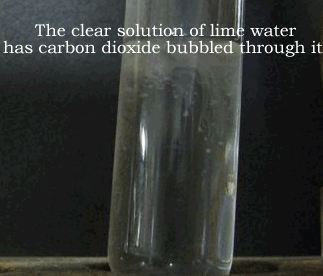Properties of carbon dioxide
The video on the right shows carbon dioxide being produced when vinegar reacts with baking powder. It also reveals two properties of carbon dioxide:
- it is denser than air and therefore sinks,
- it does not support combustion.
When bubbled through lime
water, carbon dioxide reacts to form solid calcium carbonate. This turns
the clear lime water cloudy. Click to see
a video.
2CO2(g) + Ca(OH)2(aq) => CaCO3(s) + H2O(l)
Carbon dioxide can also be
obtained by heating limestone (CaCO3) in a lime kiln.
CaCO3(s) => CaO(s) + CO2(g)
As we continue
to bubble carbon dioxide through the lime water the solution becomes increasingly
cloudy and then turns clear once more. Observe the time lapse animation
on the right.
As carbon dioxide continues to bubble through the solution, the calcium
carbonate dissolves to give a clear solution. This is because soluble
hydrogen carbonate (HCO3-) has been formed according
to the equation below.
CaCO3(s) + CO2(g) + H2O(l) => Ca2+(aq) + 2HCO3-(aq)

When carbon dioxide dissolves in water it forms carbonic acid according to the equation below.
CO2(g) + H2O(l) => H2CO3(aq)
The time lapse animation on the right shows water, with universal indicator added, change over time as dry ice (carbon dioxide) is added.
